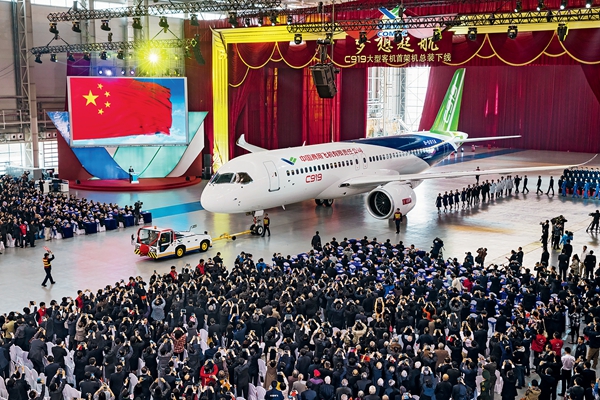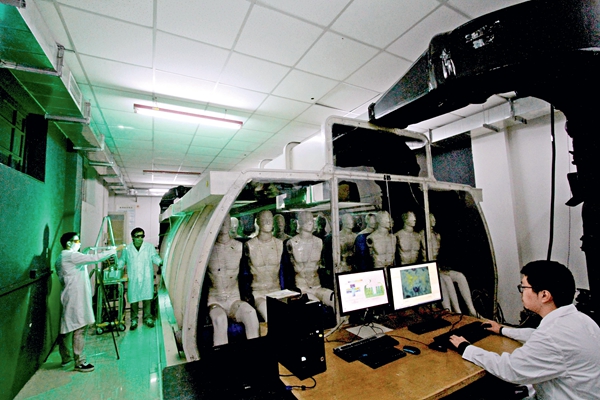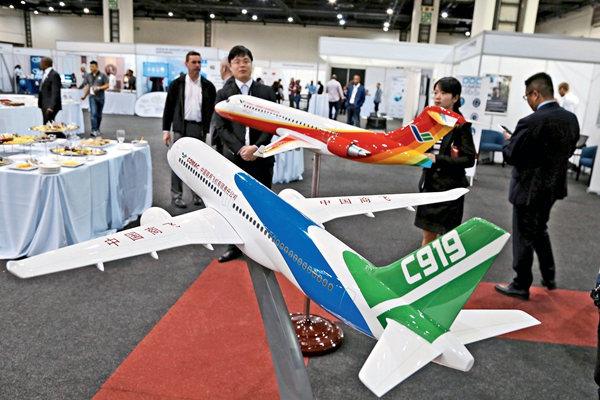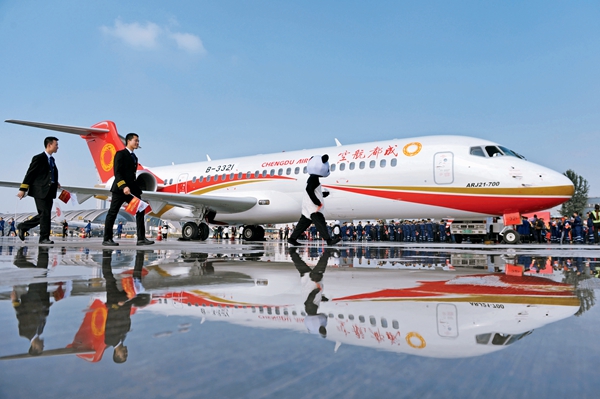Jumbo Jet Collaborative Innovation
By staff reporter AN XINZHU
CHINA has patented its first commercial passenger jet, the C919. On-board systems have been installed and static and integrated system tests have been satisfactorily carried out. Two taxi tests were completed on February 28 and March 1. The C919 is expected to make its maiden flight later this year.
The C919, designed by the Commercial Aircraft Corporation of China Ltd., is a commercial aircraft for medium and short haul flights. The production of the C919 signifies that China has joined the small group of countries capable of manufacturing commercial aircrafts outside the United States and Europe. After 10 years of development, China’s “jumbo jet dream” has finally come true. This development process was deeply rooted in international technology exchange. China has moved from being a subcontractor manufacturing components to a key player capable of independently designing and producing airplanes, thereby changing its role in the global aviation industry and gradually acquiring core technology.
Collaborative Innovation in Core Technology
The C919 project was finally approved 10 years ago, but China has actually been dreaming of making large airplanes for the last 46 years.
China developed its first large passenger aircraft, the Y-10, in 1970. It had its maiden voyage in 1980, but the project was canceled in 1985. At that time, China’s weak industrial base and poor technology could not guarantee the safety of the aircraft. As a result, the Y-10 was never commercially produced.
In early 2007, China set itself the goal of making its own passenger planes to catch up with the two major aviation giants dominating the market – Boeing in the U.S. and Airbus in Europe. The Commercial Aircraft Corporation of China Ltd. (COMAC), founded in May 2008, is a major part of the nation’s large jet program. The necessary breakthroughs in technology and equipment manufacturing, however, could not be achieved overnight. COMAC created the Chinese jumbo model in a process of continuous development and technological exploration, restructuring the industry.

COMAC owns the C919 patent, according to Chen Yingchun, vice chief designer of the C919. Key processes like design, final assembly, test flights and sales were all carried out with COMAC at the core. China independently designed and tested the aerodynamic configuration, also overseeing aircraft design, performance tests, parts manufacturing and system integration: C919 is literally “Made in China.”
Wings are not only the major load-bearers of the overall structure, but also the most difficult components to manufacture. With newly developed Chinese supercritical airfoil technology, the C919 maintains performance levels even with two meters of upturn in the static test. The fuel consumption of large passenger jets is enormous. In order to achieve fuel-efficiency, supercritical airfoil technology was employed, increasing aerodynamic efficiency by 20 percent and reducing drag by 8 percent.

The supercritical airfoil used on the C919 model was developed by the Aviation Industry Corporation of China (AICC). However, one crucial technological feature in the manufacture of airplane wings – shot peening on large integral wing panels – had long been a foreign monopoly, which restricted the development of large airplanes in China. After much research and systematic experiments, AICC finally mastered supercritical airfoil technology and applied for a patent. It thus circumvented the foreign monopoly and became one of the few companies in the world with intellectual rights to the technology.
This epitomizes the nature of the technological research involved in C919 development. Western countries continue to lead the way in developing large passenger aircraft and are veterans on the international market, while China still faces technical obstacles. COMAC focused on developing 102 key technologies during C919 production, not only achieving breakthroughs in new materials, modern manufacturing and advanced power, but also promoting the development of mechanics, computational mathematics and other core subjects in China. As a result, the country’s technology diffusion ratio has increased to 60 percent.
An International Industry Chain in Aircraft Manufacturing
The C919’s dimensions are very similar to those of the Boeing 737 and Airbus A320. Fuselage length is 38.9 meters, wingspan 35.8 meters, and height 12 meters. There are two models. The standard version has a range of 2,200 nautical miles (NM). The other model has an extended range of 3,000 NM. It can cruise at a maximum altitude of 35,000 feet. Compared with similar models on the market, the C919 has larger passenger capacity and lower fuel consumption.

Before it started to develop the C919, China was already an important supplier of global aircraft components. Currently, more than 8,000 Boeing airplanes currently in service sport components made in China. Airbus has found it much easier to install these components since the company set up a final assembly line in Tianjin in 2008.
These Chinese suppliers were therefore the natural choice of airframe suppliers for the C919 when China launched its commercial airplane initiative. AICC, supercritical airfoil supplier for the C919, manufactures wings for the Airbus A320 and has manufactured tailfins for more than 3,000 new Boeing 737s. The AVIC SAC Commercial Aircraft Company Ltd., responsible for producing C919 tailfins, is the exclusive supplier of the tailfins for Boeing 787s.
Global sourcing and collaboration is an unstoppable trend in the aviation industry. Homegrown commercial airplanes are designed in China and complete their final assembly here, but all essential components are sourced through international bidding, increasing the production capacity of domestic enterprises with an injection of new technology.
After the bidding, GE, Honeywell, CFM and 13 other international companies were chosen as suppliers of the C919’s onboard systems. During this process, China promoted cooperation between global suppliers and domestic companies, establishing 16 joint ventures in the areas of avionics, flight control, power supply, fuel, landing gear and other airplane systems.
Such cooperation has encouraged more Chinese aviation companies to participate in core development areas. China played a part in key areas of the C919 project, such as avionics, flight control and engine technology. The fuselage and aerodynamic configuration was mostly completed by AICC and COMAC. Landing gear, auxiliary power, the hydraulics and power supply systems were jointly manufactured by AICC and its foreign partners.
Production of the C919 highlights the abundant resources to be found in China. Twenty-two provinces and municipalities and over 200 companies were involved in the development of the jumbo jet, as well as 16 materials suppliers, and 54 parts suppliers and financial institutions providing financial services and leasing cooperation. Industrial aviation parks were built in Shanxi, Jiangsu and Hunan, where hundreds of thousands of workers were employed in the manufacture of the jumbo jet.
Entering the Global Arena
Strict inspection to meet international standards is required before the new airplane formally enters the market.
One of the remaining hurdles for China is obtaining a market entry certificate for its large commercial passenger airplane. To get the Standard Airworthiness Certificate, all airplanes must be tested in accordance with the international aviation safety standard system, either by the U.S. Federal Aviation Administration or the European Aviation Safety Agency. Jumbo jets are not permitted to fly over foreign territories without the certificate. C919 is currently undergoing tests to verify its safety.
China has signed bilateral airworthiness agreements with the U.S. and a few other countries. Twenty MA60 airplanes have been sold to seven foreign countries, including the Congo. Ninety-five Y12 airplanes have been sold to 20 countries, including Uganda. The approval of these models prompted Chinese aviation products to enter the international market.

The ARJ21 regional jet, developed by COMAC, passed the Civil Aviation Administration of China inspection and was strictly reviewed by the FAA prior to the development of the C919. Chengdu Airlines Co., Ltd. used the ARJ21 commercially for the first time in 2015.
Wu Jian, who led the ARJ21 review team, is former vice director of CAAC East China Regional Administration. He said that the time needed for the C919 to acquire the airworthiness certificate should be greatly reduced after the tough inquiries made by the ARJ21 project. It took 12 years for the regional jet to qualify for commercial aviation transport.
In order for Chinese commercial aircraft to meet global requirements, China has been working on establishing an international standard safety system for the commercial aviation industry, but it will be some time yet before China catches up with its Western counterparts. The current airworthiness system in the U.S. and Europe was set up over five decades ago and is continuously being improved. Western countries, with their wealth of talent and experience, have progressed both in terms of safety and aircraft manufacturing capacity. In contrast, the airworthiness system in China is in its infancy and needs to be further developed.
There is still a long way to go before the C919 can compete with Boeing and Airbus. According to the Executive Editor of Aerospace Knowledge Wang Yanan, the C919 model used in test flights was the standard version and it is important to produce an improved and upgraded model in accordance with the international aviation development process. The standard model is still far from being a success on the international market. After it first rolled out the A320, it was 20 years before Airbus finally started making a profit.
COMAC has received 570 orders for the C919 from 23 customers including domestic airlines like Air China and international clients such as GECAS. COMAC has not yet confirmed the price of the C919 but it is expected to be under US $50 million. Similar models – the Boeing 737 and the Airbus A320 – cost US $50-80 million.
The C919 is already preparing for its maiden flight. This year will be milestone for commercial aviation in China. In addition to the C919 launch, COMAC will commence development of a wide-body aircraft, and aims to achieve unit production of the new regional jet ARJ21. China is on the cusp of a “Made in China” era for commercial aircraft.
